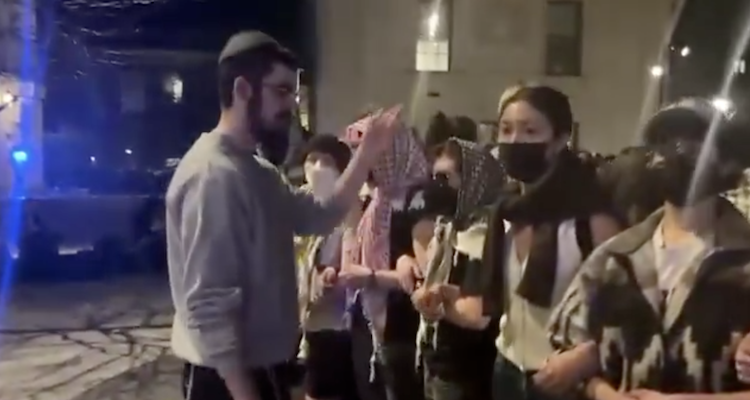In high school, we used to joke that when it came to troublemaking, there was strength in numbers. After all, the teacher can’t, say, kick the whole class out of class, right?
We didn’t account for the creativity of the teacher, who figured out the logistics of kicking out a classroom full of kids: She marked everyone as having been kicked out of class and then left the room herself.
Apparently the esteemed students of Yale University never learned that lesson. Last night, Yale’s masked Hamasniks reassembled to physically prevent Jewish students from moving freely through campus, a deliberate violation of the rights of the Jews and of the university’s rules. They did so, like their peers at other “elite” Institutions of Learning Things the Rest of Us Learned In High School, with the assumption that if enough of them act like segregationist yahoos none of them will get in trouble for it.
One kippah-clad Jewish student posted a video of his attempt to convince the keffiyeh kids to let him through. He points out that the crowd had just let someone who wasn’t identifiably Jewish through and requests the same privilege. The crowd declines.
Again, it’s worth zooming out a bit to be clear on the strategy here. If two chowderheads on campus physically prevented another student from walking on campus, everyone would recognize the absurdity of arguing in favor of the nobility of the chowderheads.
What are the two main differences between the two chowderheads in my example and the Hamasniks at Yale? The first is that the target of their harassment is Jewish. The second is that there are a lot of them—chowderheads as far as the eye can see.
Which one of those two circumstantial differences makes their actions go from obviously out of bounds to acceptable?
Let’s start with the first. Are you permitted to harass students on campus so long as those students are Jewish? Is there a Jewish Exception to the rulebook—not to mention the code of common decency—that makes an otherwise cut-and-dried violation of someone’s rights into permitted activity?
What about the second aspect of the case? Is harassment frowned upon when there are two perpetrators but encouraged when there are two hundred perpetrators?
While I never went to Yale Law School, I feel confident in saying that in neither case have the Hamasniks discovered a secret loophole.
Yale appears to agree. According to a statement on its website, “staff identified students who had been warned or disciplined in previous incidents that violated university policy. Those students have received written notice today that they are subject to immediate disciplinary action. The university continues to investigate the event actively and will hold those who violated university policies accountable. Those who violate the university’s policies and instructions (https://secretary.yale.edu/student-life/use-outdoor-spaces) regarding use of outdoor spaces face law enforcement and disciplinary action, including reprimand, probation, suspension, or expulsion.”
The statement also had some news for the event’s organizers: “Last night, Yalies4Palestine sent out calls over social media for others to join the event, and this morning joined with an unregistered group in public statements taking credit for the event. This occurred only one day after Yalies4Palestine had met with Yale College officials to discuss recent policy violations and were warned that further violations would jeopardize the group’s privileges. Because Yalies4Palestine has flagrantly violated the rules to which the Yale College Dean’s Office holds all registered student organizations, Yale College today notified Yalies4Palestine that the College is withdrawing its status as a registered student organization.”
The statement further asserted that anti-Semitism is bad and that the cause of academic freedom is not served by physically preventing students from moving about on campus. This last one is somewhat controversial these days: Most academics and students are willing to admit that Jewish students also have academic freedom but only if you put them under oath.
We’ll see what the individual disciplinary actions turn out to be, but the incident has already drawn the attention of the Civil Rights Division at the Department of Justice, so Yale will be closely watched on this one. Good thing the Hamasniks have made it so easy for them this time by ostentatiously flaunting their objectively evil intentions.


















